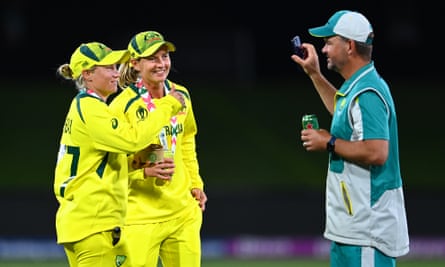In some ways it seems strange for Matthew Mott to decide that this is the moment to move jobs. Since 2015 he has been building the Australian women’s cricket team into a canary-yellow juggernaut, bristling with firepower on every deck.
Faster bowlers, bigger hitters, fitter fielders, better athletes: even as other countries have raised investment in the women’s game, Australia are further ahead of the pack than ever. They may still be basking in a recent 50-over World Cup win, but there are more international trophies to target very soon. Mott has helped create a dynastic power, one poised to dominate the next few years like never before.
Coaching an England men’s team, even in a position that only covers limited-overs cricket, is a different prospect. A sport media culture fed on football manager stories will offer less goodwill, more causticity and a strong chance of a curtailed tenure. It is curious why this was the challenge that drew Mott’s interest. While plenty of coaches treat women’s sport as a career stepping stone to men’s equivalents, he never has.
Mott did his apprenticeship in men’s first-class cricket at New South Wales and Glamorgan before winning the Australian job, where he signed three contracts while exceeding seven years in charge. He had comfortably the best job in women’s cricket and didn’t want the travel demands of all formats for a men’s team. It was only England splitting the job into separate white and red-ball coaches that won him over.
For all that his international Eoin Morgan is impressive now, he needed patience at the start. His Australian team started in 2015 with an Ashes win in England, but in the next two years lost the final of the T20 World Cup, the semi-final of the 50-over World Cup and the last two matches of a home Ashes to turn a series lead into a tie.
Given the relative strengths in women’s cricket, Australia saw winning as par. Mott could have been moved along. Instead he was allowed to reshape the team. He wanted to embolden players who he thought were great frontrunners but fumbled under rare instances of pressure.
Mott as a player was solid and low-key, an opening bat who spent 10 Sheffield Shield seasons knocking out modest tallies of runs. As a coach he has a similar temperament, the quiet counsel for a phlegmatic captain like Meg Lanning, the pair a couple of steely eyed old timers, squinting against the glare while leaning on a fence rail and chewing a stalk of grass.

He creates a sense of calm around a team, but combines it with ambition for players more talented than he was. The wicketkeeper Alyssa Healy had a parlous batting record, but ability that Mott believed in. He told her she would open for an extended period and should attack without fear. She has since made thousands of runs and been the team’s big-stage performer. Beth Mooney was peripheral as Healy’s understudy, but has been trusted with increasingly important jobs and delivered repeatedly. Tahlia McGrath has had a similar run in recent times.
At the same time, he has shown flexibility and a willingness to make difficult calls. At the turning point in 2017, Mott moved on from players who the game had caught up with and brought through a new generation from the domestic Big Bash League. A far stronger squad approach has followed, with options available for all conditions.
Selections change accordingly. Ellyse Perry, Megan Schutt, Jess Jonassen, Ash Gardner, Amanda Wellington: players who would be all-format locks for any other team havebeen rested, rotated, recused or recessed. In the meantime, Australia have won three World Cups, dealt out two Ashes thrashings and in five years of 50-over matches have lost one out of 39.
So what can he do for England’s men? All of the above. Take a setup that is better than most and streamline it. Set high ambitions with a plan for achieving them. Demand that a team with claims to superiority delivers on the promise. England have been used to winning but also require transition.
The champions of 2019 are up against the clock: Jason Roy, Jonny Bairstow, Moeen Ali, Jos Buttler, Adil Rashid. Spanning formats will stretch Ben Stokes and Joe Root thin. Jofra Archer and Mark Wood can’t avoid injury. Eoin Morgan is hanging on by his fingernails, surely no longer than the T20 World Cup later this year. Mott’s job is to go beyond one group of players who have been good for one generation, turning them into a winning culture that transcends personnel.
His four-year contract says that England’s administrators are thinking in the longer term and Mott’s own history says that he doesn’t mind sticking around for an extended period. The only person who this might not suit is Morgan, the captain who until recently looked most likely to graduate to the job himself when he retired as a player. But the situation has changed.
If Mott can do with his new job something approaching what he did with his previous one, it will be a hell of a spectacle for everyone. If he can’t, he might end up wistfully watching the fireworks that the Australian women’s players keep shooting into the sky.
